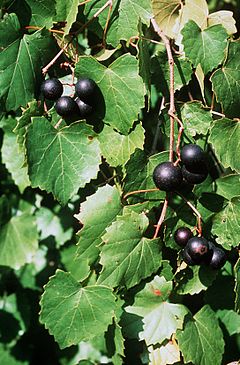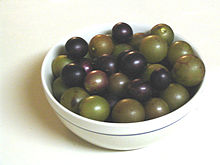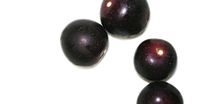- Muscadine
-
Muscadine 
Scientific classification Kingdom: Plantae Division: Magnoliophyta Class: Magnoliopsida Order: Vitales Family: Vitaceae Genus: Muscadinia Species: M. rotundifolia Binomial name Muscadinia rotundifolia Muscadines (Muscadinia rotundifolia) are a grapevine species native to the present-day southeastern United States that has been extensively cultivated since the 16th Century. It differs from Vitis spp. in its number of chromosomes (2n=40 chromosomes) and its morphology. Its natural range is recognized in the following states of the US: Alabama, Arkansas, the Carolinas, Delaware, Florida, Georgia, Kentucky, Louisiana, Maryland, Missouri, Mississippi, Oklahoma, Tennessee, Texas, Virginia, and West Virginia.[1] They are well adapted to their native warm and humid climate; they need fewer chilling hours than better known varieties and they thrive on summer heat.
Muscadine berries range from bronze to dark purple to black in color when ripe. However, many wild varieties stay green through maturity. They have skin sufficiently tough that eating the raw fruit often involves biting a small hole in the skin to suck out the pulp inside. Muscadines are not only eaten fresh, but also are used in making wine, juice, and jelly.
Muscadine grapes are rich sources of polyphenols and other nutrients studied for their potential health benefits. Gallic acid, (+)-catechin and epicatechin are the major phenolics in seeds, while ellagic acid, myricetin, quercetin, kaempferol, and trans-resveratrol were the major phenolics in the skins.[2]
In a natural setting, muscadines are important plants for improving wildlife habitat by providing cover, browse, and fruit for a wide variety of animals.[3]
Contents
Taxonomy
Although in the same genus Vitis with the other grapevine species, muscadines belong to a separate subgenus, Muscadinia (the other grapevine species belong to subgenus Vitis), and some have suggested giving it standing as a genus of its own. Some taxonomists have also suggested splitting two additional species off from Vitis rotundifolia, Vitis munsoniana and Vitis popenoei. All have 40 chromosomes, rather than 38, are generally not cross-compatibile with other Vitis species, and most hybrids between the subgenera are sterile. A few, however, are at least moderately fertile, and have been used in breeding.
Cultivars
There are over 300 muscadine cultivars growing in the southern states. These include bronze, black and red varieties and consist of common grapes and patented grapes.[4]
Unlike most cultivated grapevines, many muscadine cultivars are pistillate, requiring a pollenizer to set fruit. A few, however, such as 'Carlos' and 'Noble', are perfect-flowered, produce fruit with their own pollen, and may also pollinate pistillate cultivars.[citation needed]
Cultivars include Black Beauty, Carlos, Cowart, Flowers, Fry, Granny Val, Ison, James, Jumbo, Magnolia, Memory (first found on T.S. Memory's farm in 1868 in Whiteville, NC), Mish, Nesbitt, Scuppernong, Summit, Supreme, Thomas,[4][5] Produced by the University of Florida, the cultivar, 'Southern Home', contains both muscadine and subgenus Vitis in its background.
Crops can be started in 3–5 years. Commercial yields of 20-45 tonnes per hectare (8-18 tons per acre) are possible. Muscadines grow best in fertile sandy loam and alluvial soils. They grow wild in well-drained bottom lands that are not subject to extended drought or waterlogging. They are also resistant to pests and diseases, including Pierce's disease, which can destroy other grape species. Muscadine is one of the grape species most resistant to Phylloxera, an insect that can kill roots of grapevines.[6]
Wine
 Some muscadines in a bowl; the green ones are scuppernongs
Some muscadines in a bowl; the green ones are scuppernongs
Muscadines have been used for making commercial fine wines and port wines dating back to the 16th Century in and around St. Augustine, Florida. Today, vineyards throughout the Southeast produce muscadine wines of various qualities.
The typical muscadine wine is sweet because vintners traditionally add sugar during the winemaking process; the wine is often considered a dessert wine although some drier varieties exist. The term scuppernong refers to a large bronze type of muscadine originally grown in North Carolina; it is also used in making wine, principally dry red table wine.Appellations
Appellations producing Muscadine wines:[7]
- America (Country Appellation)
- Alabama (State Appellation)
- Arkansas (State Appellation)
- Florida (State Appellation)
- Georgia (State Appellation)
- Louisiana (State Appellation)
- Mississippi (State Appellation)
- North Carolina (State Appellation)
- South Carolina (State Appellation)
- Tennessee (State Appellation)
- Texas (State Appellation)
Other products
Other traditional Southern US muscadine-derived food products are readily available: jelly, preserves, syrup, and sauce. The fresh grape is available in season, September and October.[8] The juice is available, white and colored. Raisins are used to make the wine (scuppernong), but are not generally available.
The wild progenitor of the muscadine grape still grows freely in southeastern USA. This one from Indiantown, South Carolina.
Resveratrol and other polyphenols
See also: Wine and healthAs muscadine grapes are notable for their highly pigmented, thick skins in which the content of polyphenols is known to be high,[2] research interest in describing these phytochemicals is significant.
Resveratrol is a polyphenol produced by many plants (including grapes) as a natural antifungal, and is widely thought to be health-promoting. Red wine typically contains between 0.2 and 5.8 mg/L,[9] depending on a range of factors, while white wine has much less. This is because most of the resveratrol in grapes is located in the skin of the grape, and red wine is fermented with the skins of the grape included, allowing the wine to absorb it; by contrast, white wine is fermented after the skins have been removed. One early report had indicated that muscadine grapes contained high concentrations of resveratrol,[10][11] but subsequent studies have found no or little resveratrol in muscadine grapes.[12][13] It appears that the initial report overestimated the amount of resveratrol because it relied on a less precise method, which could not distinguish resveratrol from ellagic acid,[12] another polyphenol found in higher concentration in muscadine grapes.
Other muscadine polyphenols include:[2][14][15]
- anthocyanins such as delphinidin and petunidin
- tannins
- quercetin
- flavan-3-ols (catechins, particularly in seeds)
- gallic acid
- ellagic acid (particularly in skin)
- ellagic acid glycosides
- ellagitannins
- myricetin (particularly in leaves)
- kaempferol
Interestingly, the rank order of total phenolic content among muscadine components was found to be seeds >> skins > leaves >> pulp.[2]
Other nutrients
A Mississippi State University nutritionist reported that a purée of muscadine skins and pulp is an excellent source of dietary fiber, essential minerals and carbohydrates and is low in fat. Muscadine purée powder has more dietary fiber than oat or rice bran.[16]
Potential Medicinal Uses
In a randomized, double-blind, placebo-controlled crossover trial, 50 adults with coronary disease or ≥1 cardiac risk factor received muscadine grape seed supplementation (1300 mg daily) and placebo for 4 weeks. There was no statistically significant increase in brachial flow-mediated vasodilation or a significant change in other biomarkers of inflammation, lipid peroxidation, or antioxidant capacity. However there was a significant increase in resting brachial artery diameter. The clinical significance of this is not clear.[17]
Anti-cancer evidence
As one of nature's richest sources of polyphenolic antioxidants,[2] muscadines have been studied for their potential health benefits which include preliminary evidence for effects against cancer mechanisms. To date, in vitro studies have shown positive effects of muscadine phenolics against blood, colon and prostate cancers.[18][19][20]
Nutritional information
100g of muscadine grapes contains the following nutritional information according to the USDA:[21]
- Calories : 57
- Fat: 0.47
- Carbohydrates: 13.93
- Fibers: 3.9
- Protein: 0.81
References
- ^ "Profile for Vitis rotundifolia (muscadine)". PLANTS Database. USDA, NRCS. http://plants.usda.gov/java/profile?symbol=VIRO3. Retrieved October 18, 2011.
- ^ a b c d e Pastrana-Bonilla E, Akoh CC, Sellappan S, Krewer G (August 2003). "Phenolic content and antioxidant capacity of muscadine grapes". Journal of Agricultural and Food Chemistry 51 (18): 5497–503. doi:10.1021/jf030113c. PMID 12926904.
- ^ Williams, Rick and Tim Baxley. Managing Native Vegetation for Wildlife. University of Florida IFAS Extension.
- ^ a b Muscadine varieties
- ^ Growing Muscadine Grapes in Oklahoma
- ^ America's First Grape: The Muscadine
- ^ "Appellations Growing Muscadine Grapes". Appellation America. http://wine.appellationamerica.com/grape-varietal/Muscadine.html. Retrieved 2007-12-01.
- ^ Muscadine Produce
- ^ Gu X, Creasy L, Kester A, et al., Capillary electrophoretic determination of resveratrol in wines. J Agric Food Chem 47:3323-3277, 1999
- ^ Ector BJ, Magee JB, Hegwood CP, Coign MJ., Resveratrol Concentration in Muscadine Berries, Juice, Pomace, Purees, Seeds, and Wines.
- ^ LeBlanc MR, Cultivar, juice extraction, ultra violet irradiation and storage influence the stilbene content of Muscadine grape (Vitis rotundifolia Michx.), PhD Dissertation, Department of Horticulture, Louisiana State University, Baton Rouge, May, 2006
- ^ a b Pastrana-Bonilla E, Akoh CC, Sellappan S, Krewer G. "Phenolic content and antioxidant capacity of muscadine grapes". J Agric Food Chem. 2003 Aug 27;51(18):5497-503. PMID 12926904. quote: "Contrary to previous results, ellagic acid and not resveratrol was the major phenolic in muscadine grapes. The HPLC solvent system used coupled with fluorescence detection allowed separation of ellagic acid from resveratrol and detection of resveratrol." "trans-resveratrol had the lowest concentrations of the detected phenolics, ranging from not detected in two varieties to 0.2 mg/ 100 g of FW (Tables 1 and 2). Our result for resveratrol differed from previous results [Ector et al., 1996] indicating high concentrations. These researchers apparently were not able to separate ellagic acid from resveratrol with UV detection alone."
- ^ Hudson TS, Hartle DK, Hursting SD, Nunez NP, Wang TT, Young HA, Arany P, Green JE. "Inhibition of Prostate Cancer Growth by Muscadine Grape Skin Extract and Resveratrol through Distinct Mechanisms". Cancer Res. 2007 Sep 1;67(17):8396-405. PMID 17804756. quote: "MSKE [muscadine grape skin extract] does not contain significant quantities of resveratrol and differs from MSEE. To determine whether MSKE contains significant levels of resveratrol and to compare the chemical content of MSKE (skin) with MSEE (seed), HPLC analyses were done. As depicted in Supplementary Fig. S1A and B, MSKE does not contain significant amounts of resveratrol (<1 ?g/g by limit of detection)."
- ^ Talcott ST, Lee JH (May 2002). "Ellagic acid and flavonoid antioxidant content of muscadine wine and juice". Journal of Agricultural and Food Chemistry 50 (11): 3186–92. doi:10.1021/jf011500u. PMID 12009984.
- ^ Lee JH, Johnson JV, Talcott ST (July 2005). "Identification of ellagic acid conjugates and other polyphenolics in muscadine grapes by HPLC-ESI-MS". Journal of Agricultural and Food Chemistry 53 (15): 6003–10. doi:10.1021/jf050468r. PMID 16028988.
- ^ United States Department of Agriculture: America's First Grape - The Muscadine
- ^ Mellen PB, Daniel KR, Brosnihan KB, Hansen KJ, Herrington DM.,"Effect of muscadine grape seed supplementation on vascular function in subjects with or at risk for cardiovascular disease: a randomized crossover trial." J Am Coll Nutr. 2010 Oct;29(5):469-75
- ^ Mertens-Talcott SU, Percival SS (February 2005). "Ellagic acid and quercetin interact synergistically with resveratrol in the induction of apoptosis and cause transient cell cycle arrest in human leukemia cells". Cancer Letters 218 (2): 141–51. doi:10.1016/j.canlet.2004.06.007. PMID 15670891.
- ^ Mertens-Talcott SU, Lee JH, Percival SS, Talcott ST (July 2006). "Induction of cell death in Caco-2 human colon carcinoma cells by ellagic acid rich fractions from muscadine grapes (Vitis rotundifolia)". Journal of Agricultural and Food Chemistry 54 (15): 5336–43. doi:10.1021/jf060563f. PMID 16848514.
- ^ Hudson TS, Hartle DK, Hursting SD, et al. (September 2007). "Inhibition of prostate cancer growth by muscadine grape skin extract and resveratrol through distinct mechanisms". Cancer Research 67 (17): 8396–405. doi:10.1158/0008-5472.CAN-06-4069. PMID 17804756.
- ^ http://www.nal.usda.gov/fnic/foodcomp/search/
External links
- The Muscadine Experience: Adding Value to Enhance Profits 2004 - 80 page technical resource for growers and processors, University of Arkansas.
Wines General Wine styles Grape varieties International
varietiesWhiteRedRegional
varietiesWine-producing countries (regions) - New South Wales
- South Australia
- Tasmania
- Victoria
- Western Australia
Other<!- interwikis ->
Categories:- Grape varieties
- American wine
- Cuisine of the Southern United States
- Crops originating from the Americas
- Flora of Delaware
- Flora of Florida
- Flora of Georgia (U.S. state)
- Flora of Kentucky
- Flora of Louisiana
- Flora of Maryland
- Flora of Missouri
- Flora of Mississippi
- Flora of North Carolina
- Flora of Oklahoma
- Flora of South Carolina
- Flora of Tennessee
- Flora of Texas
- Flora of Virginia
- Flora of West Virginia
Wikimedia Foundation. 2010.


